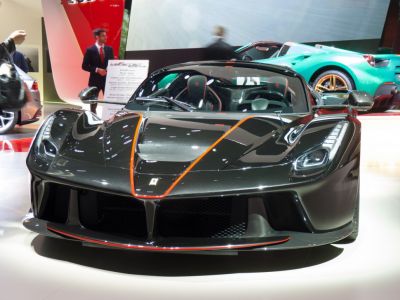 2013 Ferrari LaFerrari Dimensions, Size & Specs
2013 Ferrari LaFerrari Dimensions, Size & SpecsMeasurements of the 2013 Ferrari LaFerrari, engineered for optimal performance and comfort
| Dimensions | |
|---|---|
| Length: | 4702 mm185.1 in15.4 ft |
| Width: | 1992 mm78.4 in6.5 ft |
| Height: | 1116 mm43.9 in3.7 ft |
| Weight Specifications | |
| Curb Weight: | 1430 kg3153 lbs |
| Tire Specifications | |
| Tire Sizes: |
|
The Ferrari LaFerrari, produced between 2013 and 2016, is a pinnacle in automotive engineering, representing the brand's elite hybrid hypercar segment. This stunning coupe measures 4702 mm (185.2 inches) in length, 1992 mm (78.4 inches) in width, and stands just 1116 mm (43.9 inches) tall, encapsulating a low and aggressive stance that echoes its high-performance capabilities. Despite its formidable powertrain, LaFerrari maintains a relatively light curb weight of 1430 kg (3153 lbs), thanks to an extensive use of carbon-fiber technology and advanced lightweight materials.
The LaFerrari's tire setup consists of 345/30 R20 tires on the front and 265/30 R19 tires on the rear wheels, contributing to incredible grip and handling dynamics suited for both road and track performance. Its dimensions position it among the sleekest and widest hypercars of its time, emphasizing aerodynamic efficiency and road presence. The low height enhances downforce and stability at high speeds.
Overall, the LaFerrari combines cutting-edge hybrid technology with a meticulously engineered chassis and compact yet wide body proportions, delivering a sublime balance of speed, agility, and exclusive styling. This model remains a benchmark in car size comparisons within the hypercar category, reflecting Ferrari's innovation from 2013 to 2016.
Discover the standout features that make the 2013 Ferrari LaFerrari a leader in its class
Have a question? Please check our knowledgebase first.
The Ferrari LaFerrari, produced between 2013 and 2016, measures 4702 mm (185.2 inches) in length, 1992 mm (78.4 inches) in width, and 1116 mm (43.9 inches) in height. These dimensions contribute to its sleek, aerodynamic shape, designed for optimal performance and road presence. The relatively low height is characteristic of hypercars, promoting a lower center of gravity for improved handling.
The Ferrari LaFerrari has a curb weight of 1430 kg (3153 lbs). This weight is relatively low for a hybrid hypercar with its advanced hybrid powertrain and carbon-fiber construction. The lightweight design enhances acceleration, agility, and braking performance, helping it achieve remarkable speed and handling capabilities while maintaining structural rigidity and safety.
The Ferrari LaFerrari is equipped with front tires sized 265/30 R19 and rear tires sized 345/30 R20. The wider rear tires help in delivering maximum traction and stability during high-speed acceleration and cornering, while the slightly narrower but larger front tires provide precise steering response and handling balance. These tire dimensions complement the car's high-performance setup.
The Ferrari LaFerrari's dimensions—4702 mm long, 1992 mm wide, and just 1116 mm tall—suggest it is quite wide and very low. While the length and height should generally fit in typical residential garages (which often accommodate cars around 2 meters tall and 5 meters long), the width of nearly 2 meters (78.4 inches) means very tight clearances, especially in garages with narrow doors or storage items alongside. Careful measurement is advised, but it is generally feasible to park it in a standard garage if space is well managed.
The Ferrari LaFerrari doesn't have a direct predecessor as it was introduced as Ferrari's first hybrid hypercar, succeeding the Ferrari Enzo conceptually. Compared to the Enzo (produced 2002-2004), which is 4595 mm long, 1970 mm wide, and 1140 mm tall, the LaFerrari is slightly longer by approximately 107 mm (4.2 inches), a bit wider by 22 mm (0.9 inches), and marginally lower by 24 mm (0.9 inches). This suggests a more aggressively aerodynamic and modern design. LaFerrari benefits from technological advances, including hybrid assistance, making it a significant step forward in Ferrari's hypercar lineage.
When compared with other contemporary hypercars like the McLaren P1 and Porsche 918 Spyder, the Ferrari LaFerrari is quite competitive dimensionally. The McLaren P1 is approximately 4588 mm long and 1946 mm wide, making the LaFerrari slightly longer and wider. The Porsche 918 Spyder is shorter at around 4647 mm and narrower at roughly 1944 mm. The LaFerrari's relatively low height at just 1116 mm also helps maintain a sleek profile. Overall, LaFerrari combines a larger footprint with a lower height, giving it an aggressive, purposeful stance typical of its class.
The Ferrari LaFerrari was produced from 2013 to 2016. During this period, only 499 coupe units were made, making it an extremely exclusive and highly sought-after hypercar. Its limited production run, combined with cutting-edge hybrid technology and Ferrari's renowned performance pedigree, makes the LaFerrari a collectible masterpiece in the sports car world.
The Ferrari LaFerrari is offered exclusively as a coupe. It features an aerodynamic two-door design that emphasizes performance and aesthetics. The coupe body style helps achieve the low height and wide stance that are essential for its high-speed stability and downforce, while also maintaining Ferrari's signature aggressive yet elegant look.
The Ferrari LaFerrari has a height of 1116 mm (43.9 inches), which is lower than many conventional supercars that typically stand closer to 1200 mm or more. This low height enhances aerodynamic performance and lowers the center of gravity, improving handling. However, this also means that driver visibility can be more limited compared to higher vehicles, requiring careful attention when maneuvering in tight spaces or urban environments.
With a width of 1992 mm (78.4 inches) and length of 4702 mm (185.2 inches), the Ferrari LaFerrari is relatively wide and long, primarily designed for high-speed stability rather than compact urban maneuvering. While these dimensions contribute positively to road-holding and aerodynamic efficiency, they can make parking and navigating tight urban spaces more challenging. Drivers need to be mindful of clearances, and the car’s advanced traction and steering systems help mitigate these challenges.
Discover similar sized cars.

| Production: | 2016-2017 |
|---|---|
| Model Year: | 2016 |
| Length: | 4702 mm185.1 in |
| Width: | 1992 mm78.4 in |
| Height: | 1116 mm43.9 in |
